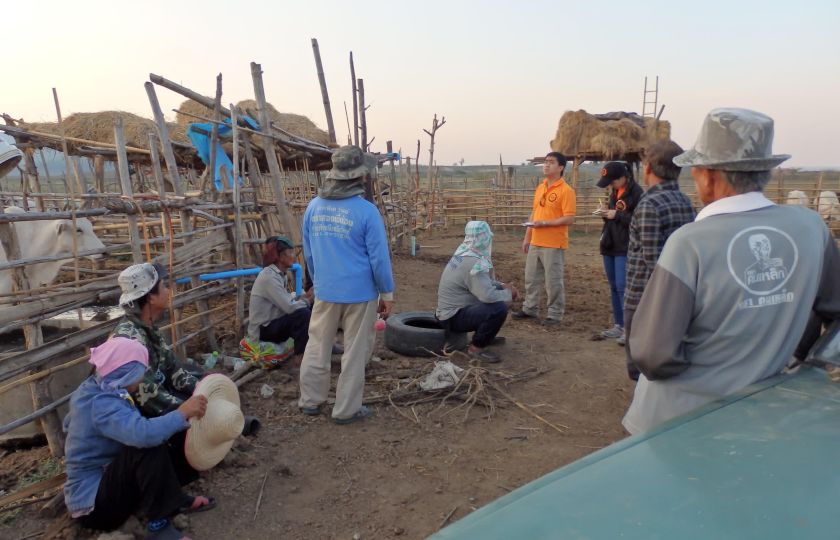Santa Fe
In Reconquista City, Argentina, raising cattle is an important part of the local economy. Unfortunately, parts of Reconquista near the Parana River are susceptible to bad flooding. We worked to protect the community and its animals.
Cows sometimes become trapped in floods and cannot be rescued. These cows can die from drowning or from illnesses related to prolonged exposure to water, such as pneumonia, diarrhoea, or arthritic diseases. Unfortunately, farmers in this area do not always pay attention to early-warning signs of flooding, and the government doesn't have the capacity to rescue all the cattle trapped on the islands of the Parana River.
In 2003, around 50,000 cows died from flooding in the area. So we can estimate that a similar number of animals would be at risk if another similar flood were to occur. Losses for the community would be around USD $17.5 million.
We worked with the local organisation Argentine Foundation for Animal Welfare (FABA) to help protect people and cows from future flooding.
Course of action
Actions were divided in four main stages:
- Research: Local consultants collected information on previous disasters, their effects on animals, prevailing development models; logistical, geographic, economic and social factors that influenced vulnerability, and economic impact. They also prepared an estimate of animals that could be affected by these disasters and existing measures to prevent them.
- Analysis and risk map: Our experts analysed threats and vulnerabilities, and developed risk maps.
- Risk reduction plan: Once the above was complete, the design and development of risk plans had to be executed by the same large and small producer actors, the local government (municipal), state agencies and veterinarians.
- Implementation: This included desk exercises and drills, as well as the dissemination of preparedness information.
The map and risk reduction plan were created across three workshops.
Public awareness
The participants developed a poster illustrating the flooding of the Parana River and the economic losses, as well as existing counter-measures. We designed preparedness announcements for local radio stations, which will be used during every flood in the future.
A poster was designed specifically for cattle owners in Reconquista. It focussed on the price of the animals and provided information about the 'moment of no return', when recovery from flooding was almost impossible. Plans for an elementary school-level component were also outlined.
Results
- Government representatives met with related and unrelated sectors and all agreed on the process.
- More efficient risk reduction tools were supplied, which were positively assessed by the participants.
- Cattle will be managed more efficiently to better plan disaster prevention.
- Two elements that played a major role in animal evacuation during flood periods were: the early warning system and the possibility of transportation.
- Early warning systems were highly successful and have been implemented over 100% of the zone, especially by radio and, where there's coverage, by internet and phone.
- There was a reduction in cattle losses during the last flood, which coincides with the work that's been done, proving its effectiveness.
- There has also been a decrease in economic losses reported by producers of the zone.
Obstacles
- Communication and linguistic differences, as well as traditional cattle raising customs and practices on the islands, present a barrier. Despite sharing the same language (Spanish), the different terminology used in regions of Central and South America initially caused some issues.
- There are a lot of cows in the region, and so subsequently their value is low. Sometimes cattle owners did not find it necessary to evacuate them, especially the animals who'd lost weight.
- The extraordinary level of the 2007 flood threw the project plan off course. To reduce the rescheduling issue caused by the flooding, and also general elections, changes in the dates of planned events had to be rearranged at more stable times.
- Socioeconomic policies around beef export can seriously distort the survival of the sector during emergencies.
- There's a lack of communication between some institutions involved. The absence of political willingness or a low place on the political agenda leads to low institutional integration.
Lessons learnt
- Social marketing is vital. It helps spread messages to target audiences, and ensure they understand and support the initiative. The need for a communications and education plan was also identified.
- People find disaster response simpler and easier to understand, internalise and apply than disaster risk reduction. Drills are needed to show the community the benefits of investing in disaster risk reduction.
- The necessary technical knowledge exists – however, not the necessary message – for early warnings to be obeyed by the cattle producers.
- Without linking it to the pre-existing risk management plan for humans in Reconquista, it will be practically impossible to develop a veterinarian plan for cattle risk reduction in this community.






